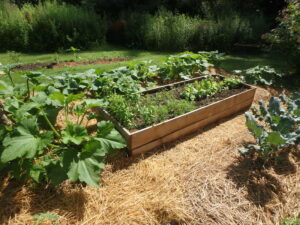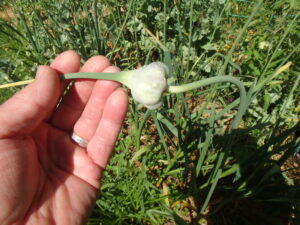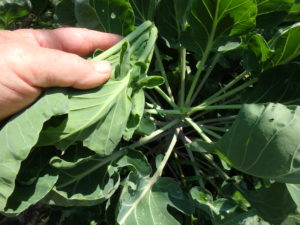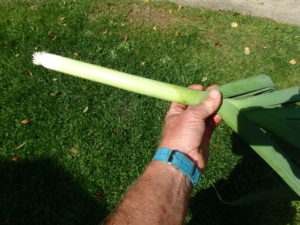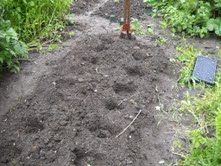What You Should Be Doing Now in the Vegetable Garden
The most vulnerable plants are those that have just been transplanted or installed. I recently moved some small Swiss chard plants from a somewhat shady place to a raised bed in full sun. Gravity works on water, not just Newton’s apple. Raised beds tend to drain of water and dry out faster than beds in the ground. The soil is warmer, too. So those Swiss chard seem to need water every day now.
I’m harvesting garlic now, too. Not the entire crop as yet. I just pull one or two for cooking as needed. I’ll pull them all in August when the leaves start to brown up. When I pull the main harvest I leave the tops on and hang them in the cellar upside down to cure. I’ve read that the bulbs will absorb additional nutrients from the leaves and stem while they cure.
I seem to be having a great year for potatoes (I have not seen a single potato bug), and should have plenty to eat and share. I planted 100 chunks of potato, and each plant should give me one to two pounds of spuds. I will start harvesting a few after they have blossomed. I like to slip my hand under a plant and “steal” a potato or two for dinner before I start the harvest. If you grow potatoes, be sure to let your children or grandkids help you when you harvest them. All kids are excited by the buried treasure!
Six Fall Chores to Do This Weekend in the Vegetable Garden
Labor Day has come and gone. Big yellow buses are slowing traffic twice a day. But it’s not time to give up on gardening and move on to watching football and waiting in a Lazy-Boy for the maple leaves to turn red. Your gardens still need you. Let’s look at the vegetable garden.
My Brussels sprout are the size of peas, very small for the time of year. But I know how to fix that. I just cut off the top cluster of leaves. That will prevent the plant from using its energy to get taller. Instead it will pump up the “sprouts” we love to eat into big, healthy veggies.
Pumpkins and winter squash need the knife, too. They will continue to elongate their stems, growing out of the garden and across the lawn. But a blossom starting now will have little chance of maturing into a potential Jack-O-Lantern. So nip off that vine and let the energy from the sun and the minerals from the roots go to the fruits that have some chance of success.
Most tomatoes are what we call “indeterminate”. That means they will continue to grow taller until they are killed by frost. Most Roma-type tomatoes (plum) are determinate, as are a few others used mainly for canning or growing in pots. They reach full size and then concentrate on producing one load of fruit that can be picked and canned. But Big Boys and most heirlooms will continue getting taller, which can be a problem.
I’ve seen tomato plants 30 feet tall in commercial greenhouses. They grow up ropes that can be lowered down for picking. But you probably are not equipped to deal with tomato plants that are even 8 feet tall. So nip off the tips of tall branches.
If you haven’t been paying attention to your tomatoes for a few weeks, you might well have some fruit laden branches laying on the ground. These are much more susceptible to rot than fruit that is tied to a stake or cage. Lift the branches and tie them to the outside of the tomato cage. I recently was give some old panty hose that I cut into strips and used to tie up mine. It’s soft and stretchy, and does a great job. String is not perfect for the job as it can cut into the stems. Old bed sheets can be cut into strips for the job instead.
Potatoes are reaching full size for many gardeners. I plant mine later than most (mid-June) and they still have nice green leaves that are turning sunshine, carbon dioxide and water into carbohydrates that will keep me plump all winter. But if yours have brown leaves, you can dig them now. Or you can steal a few by reaching under a plant or two and grabbing a spud for dinner, but leaving the plant itself undisturbed.
As with any plant that is susceptible to fungal diseases, I do not toss potato plants onto the compost pile. Squash, tomatoes and potatoes all fall into this category. I carefully dig all the plants (including leaves and roots) and put them on a brush pile I will burn this winter after snow falls. If you don’t have a burn pile, you can put them in household trash or create a separate pile in a far corner of your property. I do that to minimize fungal diseases next year.
Leeks are ready to harvest, but can stay in the ground a few more weeks. I use leeks not only for leek and potato soup, but also as a substitute for onions. And you don’t have to just use the white part of leeks. Commercial growers hill soil over the leeks as they grow, keeping a longer portion white than I do. But most of the green part of the stem is good to use, too. I pick every other one now, thinning them out, and leaving some to get even bigger.
My peppers are pathetic this year. I only planted a few, some Hungarian wax and a few sweet peppers. I got a few of the hot wax peppers early on, but the cool, rainy summer has not encouraged most plants to blossom and produce fruit.
By now my peppers must be scared that winter is coming and they have not produced enough seeds to keep their line of DNA alive. We had one night where the temperature went down to 33 degrees! That should have been a wake-up call. So I am hoping that they will bloom and produce some fruit during the hot Indian Summer days that are sure to come.
I am trying an experiment with my peppers this year. On Labor Day I dug up 2 Hungarian hot wax peppers and transplanted them into 8-inch pots. I used potting soil, not garden soil in the pots as it will stay fluffier than garden soil, which tends to compact in a pot. I am keeping them in the garden, but will carry them inside any time the temperature is predicted to go much below 50 degrees. Then I’ll carry them outside again in the morning, sort of like walking the dog. They are wind-pollinated, so being indoors will not be a problem. I’ll let you know if I get some peppers this way.
As a rabid, mad-dog gardener I never stop thinking about my garden. There is always something to try – which keeps me young.
Do you suffer from hay fever? Read about the true culprit at Henry’s blog https://dailyuv.com/news/
Potatoes
Why is it that some people use nicknames for their children that are the names of vegetables or flowers? I’m sure you are familiar with “sweet pea” as a loving epithet (even for kids who are not sweet), or “pumpkin” for children who are neither round nor orange. The French, I am told, call their lovers “petit chou” which translates as “little cabbage”. But I have never heard anyone refer to a loved one as a potato. I wonder why, since potatoes are some of the easiest of vegetables to grow. I suggest you plant some now if you haven’t already.
I always wait until June to plant my potatoes, even though I could have done so in early May. I have found that later planting decreases problems with the Colorado potato beetle. That is an observation that I have previously reported here, and other gardeners have told me that when they planted later they, too, had fewer problems. I like to joke that by planting later all the beetles have gone next door.
If you have those nasty potato beetles, what should you do? The first line of defense is hand-picking. Look for the yellowish larvae or striped adults on leaves, and pop them in soapy water. Look for orange eggs on the underside of leaves, too. Check daily as soon as you have leaves on your plants. Don’t let a second generation get started, and you will have fewer problems.
You might also try an organic spray to control beetles. It is called Bt, which stands for Bacterium thuringiensis, a naturally–occurring soil bacterium that is available at garden centers as a powder. Dilute it with water and spray on leaves. When larvae eat leaves with the bacterium, a protein in the bacterium makes them sicken and die. It is not a contact poison, and will not harm us or our critters – nor will it kill adult beetles.
Potatoes are grown from sprouted pieces of last year’s crop. I generally save potatoes from one year to the next for planting. I went 25 years without buying potatoes until we got late blight in 2010. Blight can overwinter in potatoes, so it is not advisable to keep potatoes for planting if you’ve had late blight. If you want to plant potatoes, don’t buy them at the grocery store. Most conventional potatoes are treated to prevent them from sprouting. Buy ”seed potatoes” sold for planting – they are guaranteed disease-free.
I have tried three different planting techniques, and all work just fine. Let’s start with the easiest. Loosen the garden soil with a spading fork and stir in some bagged organic fertilizer and compost to the soil. Place on the soil surface some seed potatoes (or pieces of seed potatoes) with at least two “eyes” (buds). Then cover them with six inches of hay. Add more compost or soil on top of the hay so that no light gets to the chunks of potato. As the plants grow, add more hay and/or soil. The potatoes themselves grow above the seed potato; they need 6 inches of covering to have adequate space to develop.
I have also planted potatoes in a trench 6 inches deep. I loosen the soil in the trench and add some compost and bagged organic fertilizer. I place the seed potatoes 8 to 12 inches apart, push them into the loose soil, and cover them with 2 inches of soil. As they grow I add more soil until the trench is full. Some people hill up the soil over the trench to create even more growing space.
The third way to plant is to use a post hole digger. Dig holes 6 to 9 inches deep, add compost and fertilizer in the bottom of the hole and stir. Place your potato in the hole and cover with 2 inches of soil. As the potato vine grows, it is easy to push a little soil down the hole – in fact, rain often does it for me.
If you mulch your plants with straw or hay it will help keep down the weeds and keep the soil lightly moist. I wait to mulch until plants are a foot tall.
There are many varieties of potatoes available to choose from. One of the most productive is Kennebec, the classic white Maine potato. Also very good is Red Pontiac, which has red skins and a white interior. Both are excellent keepers, staying tasty all winter and into the spring. I also grow purple-skinned potatoes; they are called All Blue or Peruvian Blue, though they are smaller and less productive than some. And I usually grow Yukon Gold, a yellow-fleshed potato that is very tasty and quite productive. Fingerling potatoes are tasty, but much less productive than those listed above.
Harvesting potatoes is one of the high points of my garden year. I start in mid- to late summer, stealing a few by reaching down under a plant and pulling up a potato or two for dinner, but not disturbing the plant. Digging potatoes in the fall is like digging for treasure, and is great to do with kids.
So plant a few potatoes this summer – and start a new trend by calling your loved one your “little potato”. As far as I am concerned, that would be a compliment!
Henry Homeyer is a gardening consultant and the author or 4 gardening books. His Web address is www.Gardening-Guy.com.



